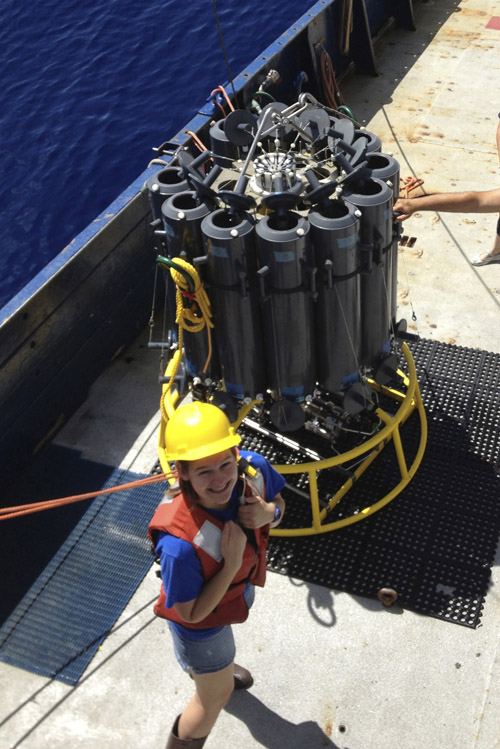Studying phages, viruses that infect bacteria, can help researchers to better understand how portions of the world’s oceans function without oxygen
Though small, viruses could hold the secrets of how vast portions of the world’s oceans function without oxygen.
University of Arizona undergraduate researcher Sarah Schwenck and postdoctoral associate Jennifer Brum are conducting a research project in the Tucson Marine Phage Lab, which is headed by assistant professor of ecology and evolutionary biology Matthew Sullivan.
By studying phages, viruses that infect bacteria, the researchers hope to learn more about oxygen minimum zones, which research suggests are expanding in size as well as depth. To collect seawater samples, Schwenck and Brum joined a two-week scientific cruise expedition off the coast of Manzanillo, Mexico.
“It’s a great environment, because you’re surrounded by 20 scientists who are doing similar work. So there’s always someone to talk to and learn more about what else is happening in the field,” said Schwenck, a UA senior who is a double major in math and biology.

Sarah Schwenck prepares to deploy the rosette, which contains bottles on a metal frame that the research team then lower into the ocean on a cable to collect water samples from different depths. (Photo credit: Jennifer Glass, Georgia Institute of Technology)
Targeting an area in the Eastern Tropical North Pacific Ocean known for its especially prominent oxygen minimum zone, Schwenck collected water samples following a transect from coastal to open ocean waters.
Collecting samples from eight different depths at each station, Schwenck found that oxygen levels began decreasing at depths of about 50 meters, dropping to nearly zero at about 100 meters, then increasing to normal below about 800 meters.
Schwenck and Brum are working this semester to analyze the samples for levels and viruses and bacteria types. “You don’t necessarily think about viruses in the environment. We do ecology, but at a very microscopic level, Schwenck said.
“What you expect to see in oxygen rich zones is occurring in oxygen minimal zones and trying to understand those processes,” Schwenck said. “Bacteria greatly impact different biogeochemical cycles, but it’s a complex ecosystem and viruses do a lot to control things.”
The researchers are also analyzing how much of a role differences in viruses plays at different spots in the ocean.
“We’re looking at how the viral community differs in areas with almost no oxygen versus the oxygenated water and what viruses exist where those two zones meet,” Brum said. “Our preliminary research shows the virus community is in fact different, but also that there’s a different community of viruses that exist right at that interface.”
Another part of the study will sequence the DNA of the viruses and the auxiliary metabolic genes they may carry.
“We already know that in surface ocean waters, viruses that infect photosynthetic cells contain photosynthesis genes to maximize viral production. These viral genes also change the way photosynthesis is done in these cells, ” Sullivan said.
“The microbes in oxygen minimum zones are obviously adapted to very different conditions than those surface-dwelling photosynthetic cells, and whether their viruses also modulate central microbial metabolisms remains an open and important question to understanding these ecosystems,” she also said.
Brum said the team will be working with others who also went on the research cruise, comparing the information they have about genes, viruses and bacteria.
“We want to know what types of viruses are there, how they differ in different regions and how they affect the bacteria, which are driving these processes,” Brum said.
The research will form the basis of the senior thesis for Schwenck. After graduation, she intends to pursue further biological studies in graduate school, with a potential career in education or science outreach. The Gordon and Betty Moore Foundation and the Undergraduate Biology Research Program provided funding for the study.
– By Eric Swedlund
*Source: The University of Arizona
